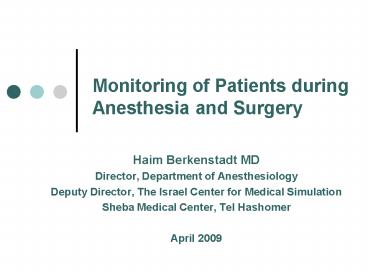Monitoring of Patients during Anesthesia and Surgery - PowerPoint PPT Presentation
1 / 35
Title:
Monitoring of Patients during Anesthesia and Surgery
Description:
Monitoring of Patients during Anesthesia and Surgery Haim Berkenstadt MD Director, Department of Anesthesiology Deputy Director, The Israel Center for Medical Simulation – PowerPoint PPT presentation
Number of Views:966
Avg rating:3.0/5.0
Title: Monitoring of Patients during Anesthesia and Surgery
1
Monitoring of Patients during Anesthesia and
Surgery
- Haim Berkenstadt MD
- Director, Department of Anesthesiology
- Deputy Director, The Israel Center for Medical
Simulation - Sheba Medical Center, Tel Hashomer
- April 2009
2
Agenda
- Requisites from anesthesia monitoring
- Physiological changes during anesthesia
- Complications of anesthesia
- Monitoring of specific physiological systems
- Generic considerations of monitoring
3
Monitoring?
- Physiological data
- Relevant
- On line measurement
- Continuous measurement
- Influence medical decision making
- Improve patients safety
- Cost effective
4
Physiological Changes During Anesthesia and
Surgery
- Respiratory Changes
- Hypoventilation
- Hypoxemia
- Hemodynamic changes
- Preload
- Afterload
- Contractility
5
Physiological Changes During Anesthesia and
Surgery
- Changes in neuromuscular function
- Changes in fluids balance
- Bleeding
- ADH
- Changes in heat exchange
- Exposure
- Vasodilatation
6
Complications of Anesthesia
- Common
- Damage to teeth
- Nausea and vomiting
- Pain
- Hypothermia
7
Complications of Anesthesia
- Life threatening
- Esophageal intubation
- Cardiac
- Respiratory
- Anesthesia machine malfunction
- Post operative residual neuromuscular blockade
- Awareness during anesthesia
8
Anesthesia Monitoring System
9
ECG
10
ECG
- Heart rate
- Heart rhythm
- Myocardial ischemia
11
Blood Pressure
- Non invasive blood pressure measurement
- Invasive blood pressure measurement
12
Non Invasive Measurement
- What do we measure?
- Where to measure?
- Cuff size?
- Interval?
13
Invasive Blood Pressure Measurement
14
Pulse Oximetry
- Oxygen saturation
- Heart rate
- Plethysmography
15
Capnography
- Mechanically ventilated patient / Spontaneously
breathing patient - Side stream / Main stream
16
Capnography
- Respiratory rate
- End tidal CO2
- Endotracheal intubation
- Cardiac output
17
Temperature - Core Body Temperature
18
Thermoregulation under Anesthesia
19
Consequences of Hypothermia
- Hemodynamic effects
- Coagulation
- Surgical wound infection
- Cardiac morbidity
- Metabolism of drugs
- Shivering
20
Temperature Measurement
- When?
- Where?
- Skin
- Esophageal
- Urine
- Blood
21
Neuromuscular Monitoring
- Nerve stimulator
- Electrical stimulus
- Measurement of motor response
22
Urine Output
- Volume status
- Increased urine output
23
Prevention of Awareness during Anesthesia
24
Prevention of Awareness during Anesthesia
25
Gas Analyzer
26
Ventilation
27
Ventilation
28
Invasive Monitoring Central Venous Pressure,
Pulmonary Capillary Occlusion Pressure, Cardiac
Output, Intra-Cranial Pressure
29
Trans-esophageal Echocardiography
30
EEG
31
Monitoring Alarms
- Adaptation to
- Age and patients normal values
- Borders of safety
- Balance between
- Safety
- False alarms
32
Trends of Parameters
33
Documentation
34
Documentation
35
Thank you
- Haim.berkenstadt_at_Sheba.health.gov.il
- 03-530-2966































